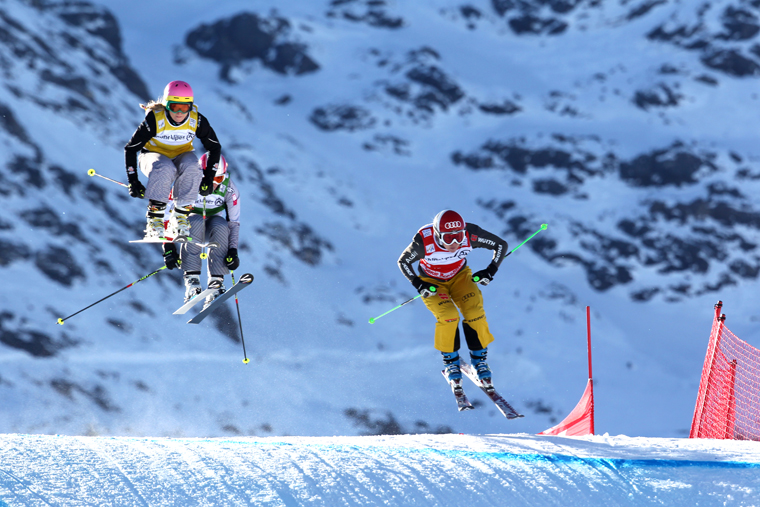15 minutes with Emily Sarsfield-Power
The former Ski Cross supremo shares her passion for skiing's maddest sport - and talks about her new role at Spyder


Nicola Iseard: Hi Emily! The last time we spoke you were competing on the world Ski Cross circuit. Remind our readers how mad Ski Cross is, what does it entail?
Emily Sarsfield-Power: Ski Cross is like that final run of the day… top to bottom of the mountain, racing your friends, first one to cross the finish line takes the glory! It’s full of adrenaline and a little dangerous at times, but a lot of fun. Four racers lined up in blocks at the top of a obstacle downhill track, complete with features, turns, large jumps and roller sections, the gate releases and you battle your way down the track and the first to cross the finish line wins… a great spectator sport.
NI: Who gets into it? Are these the most unhinged of the competitive racers, or are they serious technicians, or freeski specialists?
ESP: Ski Cross involves a varied mix of skiing techniques. Because it’s about getting to the bottom first you need the speed, so alpine technical skills are integral. Many racers have a background in alpine racing. However, the 30-metre jumps require you to be comfortable in the air, so familiarity in the park is also key. The mix of obstacles are always going to throw you around, so being very comfortable in different terrain is essential, meaning that off-piste powder days after still classed as ‘training’!
NI: Tell us of a wild race or moment that you look back on and think, ‘Wow!’
ESP: There are so many… There was always a sense of fear. My first World Cup race in 2005 certainly sticks in my mind. I turned up to France in my Peugeot 106, alone, with no coach, after a 1,000km drive. I had no idea what I was doing. During my ‘training run’ – a pre run down the track alone to work out the best line – I had a huge crash. Mid-way down there was a double roller, like a camel hump. I realised I’d be travelling at too fast to compress the rollers singularly, so I’d have to use the front roller as take-off and land on the back side of the second (the gap was large enough to park four cars!). Unfortunately, my speed wasn’t quite what I had hoped for, so I ended up skiing directly into the second like a brick wall. Pride damaged, that chairlift ride back to the top was the biggest contemplation of whether I never do this again or give it another shot … 14 years later, eight National Titles, five World Championships, and an Olympics and I think I made the right decision!
There was always a sense of fear… 14 years, eight national titles, five World Champs and one Olympics later and I think I made the right decision.
NI: It would be good for other aspiring speed demons to know how you started. And how did you make the jump from amateur?
ESP: After being introduced to skiing on family holidays from the age of three, I joined a local dry ski slope race club in my early teens. I spent many years competing and was lucky enough to represent GB at the World University Games in 2005. At this time Ski Cross was a relatively new sport and some coaches had mentioned my style of skiing would be really suited to it… I think it was the years of chasing my sister around the mountain as a child, my competitive nature and gymnastics background that made me an ‘all or nothing’ skier. You can’t think too much on a ski cross track – you just have to use the touch on the snow and react to the obstacles. Once I tried it I was hooked. I soon joined the national team.
NI: What were the decisions behind you retiring (in 2019)?
ESP: I had been competing on the World Cup circuit since 2005/6. Ski Cross can take its toll on the body, and I had suffered some big crashes. My biggest one, in 2009 on the Olympic track, resulted in me tearing all four ligaments in my knee, damaging meniscus, cartilage and fracturing my tibia and femur. Following successful reconstructions my knee then became my ‘niggle’ – I had to manage it every day for the following 10 years of competing and training. I had to access if this was really what I wanted to be doing.
After many amazing yet tough years as a self-funded athlete I achieved my childhood goal of competing in the Olympic games in 2018 and I was thinking about what the next challenge would be in my skiing. I was lucky to be approached by the ski clothing brand Spyder in 2019 to look after their brand in the UK. Nervous yet excited I jumped at the opportunity, and this was exactly the new challenge I needed… and a lot kinder on my body!
NI: Tell us about your role with Spyder today…
ESP: I am currently managing Spyder’s European Marketing department. I’m learning new things every day and loving it. Spyder has so much heritage, starting from ex-ski racer David L. Jacobs, whose aim was to produce the best ski products appropriate for the mountain conditions. Such an innovative brand, they are always pushing the limits to create technical, comfortable yet stylish ski wear, along with creating a strong community and aspiring skiers.
NI: We’ve been hearing great things about Spyder’s Factory Team campaign – can you tell us about that and how the idea for the campaign came about?
ESP: Spyder have so many awesome campaigns, from women’s confidence projects to our Pro team riders. This year they have launched a brand new Factory Team. The Factory Team was set out to give a unique opportunity to aspiring athletes in both Alpine and Freeski. Open to 14-18-year-olds, the program aims to not only support them with the best clothing but financially help with competition and training costs, educate them in increasing their exposure, and offer a mentoring program from our Pro team, which includes World Cup racers and Olympic gold medallists alike (who are also involved in actually selecting the athletes!). I wish things like this were around when I was an aspiring ski racer, it’s such a great program.
NI: Can you give us a sneak peek into any other campaigns that Spyder is working on?
ESP: I’m super excited about our Women’s campaign ‘For the art of confidence’. The four-part series explores the challenges our pro skiers face that are uniquely female, exploring topics like confidence, failure, fear and community. We get to see some of the raw reality, the tough times, which are not often spoken about that you can’t help being empowered by.
NI: You’ve also been a commentator for the BBC and Eurosport, run a Ski School in Meribel, are a charity ambassador for SnowCamp – do you have any other side projects in the pipeline?
ESP: Well, I got married … does that count!? I’ve juggled all sorts of jobs! As I was self-funded in my ski career, I always had to think outside the box to finance my training and competition programme, so I managed to juggle many roles to make it work, from my ski school to commentating when I was injured. I love working with the charities – the Ellie Souter foundation and SnowCamp have a huge impact on individuals through snowsports and it’s an honour to be part of that.
NI: Finally, what is the best piece of advice that you have been given?
ESP: ‘Reach for the moon, even if you miss you’ll always land among the stars’! And the other one I like to live by is: ‘always take the opportunity’.
